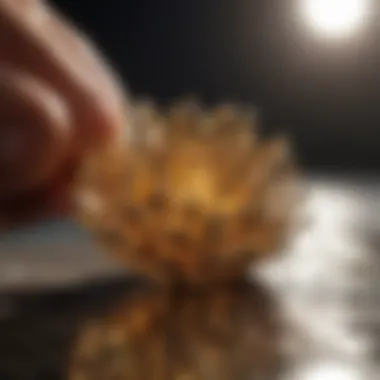Deciphering the Distinctions Between 10kt Gold and 14kt Gold


Brief Overview of Gold Karats
When delving into the realm of gold jewelry, one cannot overlook the vital disparity between 10kt and 14kt gold. Understanding the differences between these two gold types is crucial in making informed decisions while purchasing jewelry pieces. This article aims to shed light on the composition, durability, value, and suitability of 10kt and 14kt gold, offering valuable insights for those navigating the intricate world of gold jewelry.
Composition and Purity
Gold is universally cherished for its lustre and elegance. The 'karat' unit is used to denote the purity of gold alloys. In this context, 10kt gold comprises 41.7% pure gold mixed with other metals for durability. On the contrary, 14kt gold contains a higher percentage of pure gold, standing at 58.3%, making it more valuable and sought after for its radiant hue.
Durability and Wearability
The karat of gold directly impacts its durability and wearability. 14kt gold, with its higher gold content, offers superior durability and is less prone to tarnishing or discoloration compared to 10kt gold. Jewelry pieces crafted from 14kt gold are suitable for daily wear and can withstand the rigors of regular use, making them ideal for those seeking long-lasting jewelry items.
Value and Market Perception
The karat weight of gold significantly influences its market value and perception. 14kt gold, possessing a higher gold content, is inherently more valuable than its 10kt counterpart. When it comes to investment pieces or heirloom jewelry, 14kt gold holds greater allure due to its intrinsic value and timeless appeal in the eyes of discerning buyers.
Suitability for Jewelry Pieces
The choice between 10kt and 14kt gold ultimately boils down to the intended use of the jewelry piece. 10kt gold, with its lower gold purity, is often preferred for everyday jewelry that undergoes substantial wear and tear. In contrast, 14kt gold, prized for its elevated gold content, is the preferred choice for special occasion jewelry or pieces meant to be treasured for a lifetime.
Conclusion
Differentiating between 10kt and 14kt gold is pivotal in selecting the perfect gold for your jewelry needs. By grasping the nuances in composition, durability, value, and suitability offered by each gold type, you equip yourself with the knowledge to make well-informed decisions when adding exquisite gold jewelry pieces to your collection.
Introduction
Gold has always held a special allure, captivating humanity with its timeless beauty and intrinsic value. In the realm of precious metals, the distinction between 10kt gold and 14kt gold stands as a crucial juncture for jewelry enthusiasts and connoisseurs alike. This article endeavors to unravel the intricate tapestry of disparities between these two variants of gold, offering a nuanced exploration of their composition, durability, value, and suitability for diverse jewelry creations.


As we embark on this illuminating journey, it is paramount to comprehend the pivotal role that gold karats play in the jewelry landscape. By deciphering the essence of karats and distinguishing the characteristics of 10kt and 14kt gold, readers will glean essential insights to navigate the intricate world of gold jewelry with confidence and acumen. Let us delve deeper into the intricacies that delineate 10kt gold from its counterpart, 14kt gold, unfurling a narrative that melds knowledge with discernment.
Understanding Gold Karats
In the realm of precious metals, understanding the distinction between 10kt gold and 14kt gold is paramount. This section serves as a foundational pillar in the discourse on gold karats, elucidating the intricate differences that dictate the quality, composition, and value of these esteemed metals. By unraveling the complexities of gold karats, readers will embark on a journey of enlightenment, paving the way for making informed decisions in the realm of luxurious adornments and investments.
What is a Karat?
Delving into the essence of gold karats unveils a fascinating realm where purity and craftsmanship converge. A karat, denoted by the abbreviation 'kt,' signifies the proportion of pure gold present in an alloy. In essence, a 10kt gold piece contains 41.7% of pure gold, while a 14kt gold piece comprises 58.3% of the precious metal. Understanding karats empowers jewelry connoisseurs to decipher the richness and durability of their gold possessions, shaping a profound appreciation for the artistry of these exquisite creations.
10kt Gold
As a stalwart in the jewelry industry, 10kt gold embodies a perfect harmony of durability and affordability. Composed of 41.7% pure gold and a meticulous blend of other metals such as copper and silver, 10kt gold presents as a versatile option for crafting jewelry pieces that withstand the test of time. While slightly lower in purity compared to its 14kt counterpart, 10kt gold shines with a distinct allure, making it a popular choice for everyday adornments that exude elegance and longevity.
14kt Gold
Elevating the sophistication of gold jewelry, 14kt gold stands as a beacon of opulence and refinement. Boasting a higher pure gold content of 58.3%, this lustrous metal exudes a radiant glow that captivates the beholder. The intricate alloy composition of 14kt gold, blending pure gold with durable metals like copper and zinc, yields a harmonious fusion of strength and beauty, making it a cherished choice for exquisite jewelry pieces that exude timeless charm and allure.
Key Differences Between 10kt and 14kt Gold
The juxtaposition of 10kt and 14kt gold unveils a tapestry of nuances that shape the essence of fine jewelry. While 10kt gold prioritizes durability and affordability, 14kt gold takes center stage with its superior purity and luster. The key differences between these two variants lie in their composition, color intensity, and market value, offering discerning individuals a spectrum of choices to align with their preferences and style. By discerning the subtle disparities between 10kt and 14kt gold, aficionados of fine jewelry can embark on a personalized journey of elegance and sophistication.
Composition of 10kt Gold
In the realm of gold jewelry, understanding the intricacies of gold composition is paramount. This section delves into the essential topic of the Composition of 10kt Gold, shedding light on the specific elements that constitute this particular type of gold.
When discussing the Percentage of Pure Gold in 10kt gold, it's crucial to note that 10kt gold contains 41.7% pure gold. This lower percentage of pure gold indicates that 10kt gold is a less valuable and less pure form of gold compared to higher-karat options, like 14kt gold. Despite its lower purity, 10kt gold remains popular due to its affordability and durability.
Moving to Alloy Composition, 10kt gold is a blend of 41.7% pure gold with other metal alloys like copper, silver, and zinc. These alloys are added to enhance the metal's strength and durability. The presence of these additional metals influences the color and properties of 10kt gold, making it more robust and suitable for everyday wear.


The Color and Appearance of 10kt gold are distinct, typically showcasing a slightly paler hue compared to higher-karat gold options. This color difference results from the higher concentration of alloy metals in 10kt gold. While some may prefer the richer color of higher-karat gold, 10kt gold's unique shade appeals to individuals seeking a more affordable yet durable gold option for their jewelry pieces.
Composition of 14kt Gold
In the realm of fine jewelry, the composition of gold plays a pivotal role in determining its quality and characteristics. Thus, understanding the composition of 14kt gold is paramount in grasping the nuances between various gold types. 14kt gold consists of 58.3% pure gold, also known as 24 karat gold. It is alloyed with metals such as copper, silver, and zinc to enhance its strength and durability. This meticulous blend of pure gold with other metals results in a beautiful balance between luxurious gold hue and sturdy alloy properties.
Percentage of Pure Gold
When it comes to 14kt gold, the percentage of pure gold present is approximately 58.3%. This particular percentage signifies the proportion of gold in the alloy, with the rest comprising other metals like copper and silver. The incorporation of these additional metals not only strengthens the gold but also influences its color and durability. Jewelers often opt for 14kt gold due to its optimal balance between purity and durability, making it a popular choice for crafting exquisite jewelry pieces.
Alloy Composition
The alloy composition of 14kt gold involves a meticulous fusion of metals to create a robust and versatile material for jewelry making. Typically, 14kt gold consists of 58.3% pure gold blended with 41.7% other metals. Copper, silver, and zinc are commonly used in this alloy, contributing to its unique properties. Copper enhances the gold's durability, while silver and zinc play a role in modifying its color and luster. This well-calibrated mix results in a gold alloy that is not only beautiful but also durable enough to withstand daily wear.
Color and Appearance
The color and appearance of 14kt gold epitomize the artistry of alloy composition. Known for its warm and lustrous hue, 14kt gold strikes the perfect balance between pure gold's rich yellow and the subtle tones added by the alloying metals. Copper infusions lend a reddish tint, while silver and zinc impart a touch of coolness to the gold's color palette. This harmonious blend of metals gives 14kt gold its distinct appearance, making it a favored choice for crafting exquisite jewelry pieces with a unique aesthetic appeal.
Durability Comparison
Durability is a crucial factor when considering gold jewelry, especially when comparing 10kt gold and 14kt gold. Understanding the durability differences between these karats is essential for making informed decisions on which type of gold best suits your needs. Durability encompasses various elements that impact the longevity and appearance of your jewelry, such as wear resistance and scratch resistance. By delving into the durability aspects, you can ensure that your gold jewelry withstands daily wear and tear, maintaining its beauty for years to come.
Strength and Wear Resistance
Strength and wear resistance are key aspects of gold jewelry durability. In the case of 10kt gold, which contains 41.7% pure gold and a higher proportion of alloys, it is known to be stronger and more resistant to wear compared to 14kt gold. The increased alloy content in 10kt gold provides added strength, making it a suitable choice for jewelry pieces that are subject to frequent use or potential impact. This higher strength can help prevent bending or warping of delicate designs, enhancing the longevity of the jewelry.
Scratch Resistance


Scratch resistance plays a vital role in maintaining the pristine appearance of gold jewelry. While both 10kt and 14kt gold are susceptible to scratches due to their higher alloy content, 10kt gold tends to resist scratches better than 14kt gold. The hardness of the alloys in 10kt gold contributes to its improved scratch resistance, ensuring that your jewelry remains free from unsightly marks or blemishes. Considering the wear and tear that jewelry experiences daily, opting for 10kt gold for its enhanced scratch resistance can prolong the lifespan and luster of your prized possessions.
Value and Pricing
Gold has always carried an intrinsic value that transcends mere monetary worth. Understanding the value and pricing mechanisms associated with different karats of gold is paramount in the realm of jewelry. When exploring the dichotomy between 10kt and 14kt gold, delving into the complexities of their respective market values unveils a trove of insights. Market value serves as a pivotal determinant in assessing the desirability and investment potential of gold ornaments. It fluctuates with changing economic landscapes and trends in consumer preferences. The allure of gold lies not only in its aesthetic appeal but also in its stable value as a precious metal that withstands the test of time.
Market Value
Market value encapsulates the current worth of gold within the commercial sphere. It reflects supply and demand dynamics, international gold rates, and market forces shaping the pricing landscape. The market value of 10kt gold differs from that of 14kt gold due to their distinct gold content percentages and desirability. Investors and jewelry aficionados monitor market value fluctuations to make informed decisions regarding gold acquisitions and sales. Understanding the intrinsic factors influencing market value empowers individuals to navigate the realm of gold trading with acumen and foresight.
Pricing Factors
When contemplating the pricing of gold jewelry, various factors come into play to determine its final cost. The karat purity, design intricacy, labor costs, and market trends all influence the pricing structure of gold ornaments. 10kt gold, with a lower gold content, tends to be more affordable compared to the higher purity of 14kt gold. Other elements such as craftsmanship quality and brand reputation also contribute to the final price tag of gold jewelry. Evaluating these pricing factors enables consumers to make judicious choices aligned with their budget constraints and style preferences.
Suitability in Jewelry Making
In the realm of jewelry crafting, the topic of suitability holds immense significance, especially when comparing the utilization of 10kt gold versus 14kt gold. The choice between these two karats can profoundly impact the quality, appearance, and longevity of the final jewelry piece. Understanding the properties and characteristics of each karat is essential in ensuring that the selected gold aligns perfectly with the intended purpose of the jewelry. Whether designing a delicate necklace, a sturdy bracelet, or a sophisticated pair of earrings, the suitability aspect forms the backbone of jewelry making decisions.
Recommended Uses
When delving into the realm of recommended uses for 10kt and 14kt gold, one must navigate through a plethora of considerations. 10kt gold, due to its higher alloy composition, is often favored for pieces that require enhanced durability, such as everyday wear jewelry like rings or bracelets. On the contrary, 14kt gold, with its higher gold content, is more suitable for intricate designs and pieces that necessitate a softer touch, such as earrings or pendants. The decision of which karat to use ultimately hinges on the desired balance between aesthetic appeal and resilience, making it imperative to align the recommended uses with the specific characteristics of each karat.
Considerations for Different Jewelry Pieces
When contemplating the creation of diverse jewelry pieces, various considerations come into play when selecting between 10kt and 14kt gold. For intricate and detailed pieces requiring a higher level of craftsmanship, 14kt gold emerges as the preferred choice due to its malleability and softer composition, allowing intricate designs to come to life with ease. Conversely, for jewelry items that demand sturdier construction to withstand daily wear and tear, 10kt gold proves to be the more suitable option, offering a balance between durability and elegance. By carefully analyzing the specific requirements of each jewelry piece, designers can make informed decisions regarding the most suitable karat to bring their creations to fruition.
Conclusion
As we bring our exploration of the disparities between 10kt and 14kt gold to a close, it becomes evident that the topic of gold karats holds substantial significance in the realm of jewelry craftsmanship and material value. Understanding the nuances between these two variants of gold is crucial for connoisseurs and creators alike, influencing decisions ranging from intricate design choices to long-term durability considerations.
In this article, we meticulously detailed the distinctions in composition, durability, and market value between 10kt and 14kt gold. By unraveling the complexities of gold karats, we have equipped our audience - be it gemstone enthusiasts, collectors, or jewelry designers - with the knowledge necessary to make informed and discerning decisions when it comes to acquiring gold jewelry.
The ability to differentiate between 10kt and 14kt gold not only empowers individuals to select the most suitable option for their specific jewelry needs but also elevates their understanding of the craft and science behind goldsmithing. Recognizing the impact of karat value on the strength, color, and overall appearance of jewelry pieces is pivotal in mastering the art of jewelry making and appreciation.
By immersing ourselves in the intricate world of gold karats, we have paved the way for a deeper appreciation of the complexities that underpin the jewelry industry. From analyzing the percentage of pure gold in each karat to delving into the unique alloy compositions and aesthetic attributes, we have cultivated a nuanced understanding that transcends mere material value.







